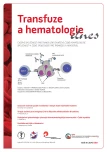Anti-Kpb antibody in pregnancy
Authors:
J. Masopust 1; M. Písačka 2
Authors‘ workplace:
Transfuzní oddělení, Krajská zdravotní, a. s., Masarykova nemocnice v Ústí nad Labem, o. z.
1; Transfuziologický úsek, Ústav hematologie a krevní transfuze, Praha
2
Published in:
Transfuze Hematol. dnes,30, 2024, No. 1, p. 41-43.
Category:
Case Reports
doi:
https://doi.org/10.48095/cctahd2024prolekare.cz4
Overview
This case report describes rare incompatibility in Kell system (antigen Kpb) during pregnancy. In literature, there are varied reports of the clinical significance of anti-Kpb ranging, from a clinically insignificant antibody to serious hemolytic disease of the fetus/newborn. In our case, the titer remained the same throughout pregnancy. Red blood cell transfusion was not necessary. Phototherapy was sufficient for postnatal hyperbilirubinemia. The case report highlights the complicated issues regarding diagnosis and potential hemotherapy in anti-HFA.
Keywords:
hemolytic disease of the fetus and newborn – red blood cell antibodies – high frequency antigens – anti-Kpb
Sources
1. Khurshid A, Alam M, Mahmood A, Khan A, Khan N, Yazdani S. Red cell antibodies against high frequency antigens, a two-year experience at a regional transfusion institute. Pak Armed Forces Med J. 2022; 72 (1): 73.
2. Seltsam A, Wagner F, Salama A, Flegel WA. Antibodies to high-frequency antigens may decrease the quality of transfusion support: An observational study. Transfusion. 2003; 43 (11): 1563–1556.
3. Salamat N, Bhatti FA, Hussain A. Anti-Rh17 (anti-Hr0): A rare diagnostic and management problem. J Pak Med Assoc. 2004; 54 (4): 215–218.
4. Písačka M, Kořínková P, Matějková E, Bolcková HT. Imunohematologie – historie, současný stav poznání a role ÚHKT. Vnitř Lék. 2012; 58 (Suppl 2): 103–114.
5. Daniels G. Human Blood Groups. Blackwell Science, 3rd edition, 2013; pp. 263–266, 285–288, 356, 487–488, 501–503.
6. Allen Jr. FH, Lewis SJ, Fudenberg H. Studies of anti-Kpb, a new antibody in the Kell blood group system. Vox Sang. 1958; 3 (1): 1–13.
7. Anderson L, White JB, Liles BA, Jack JA. A case of hemolytic disease of the newborn caused by anti-Kpb (Rautenberg). Am J Med Technol. 1959; 25: 184–188.
8. Wright J, Cornwall SM, Matsina E. A second example of hemolytic disease of the newborn due to anti-Kpb. Vox Sang. 1965; 10: 218–221.
9. Dacus JV, Spinnato JA. Severe erythroblastosis fetalis secondary to anti-Kpb sensitization. Am J Obstet Gynecol. 1984; 150: 888–889.
10. Kohan AI, Reybaud JF, Salamone HJ, et al. Management of a severe transfusional problem in a patient with alloantibody to Kpb (K4). Vox Sang. 1990; 59: 216–217.
11. Gorlin JB, Kelly L. Alloimmunisation via previous transfusion places female Kpb-negative recipients at risk for having children with clinically significant hemolytic disease of the newborn. Vox Sang. 1994; 66: 46–48.
12. Mazzara R, Lozano M, Salmerón JM, et al. Transfusion of incompatibile RBCs to a patient with alloanti-Kpb. Transfusion. 2001; 41 (5): 611–614.
13. Elhence P, Sachan D, Verma A, Kumar A, Chaudhary R. Late onset neonatal anaemia due to maternal anti-Kpb induced haemolytic disease of the newborn. Transfus Apher Sci. 2012; 47 (3): 247–250.
14. Wren MR, Issit PD. The monocyte monolayer assay and in vivo antibody activity. Abstract. Transfusion. 1986; 26: 548.
15. Eby CS, Cowan JL, Ramos RR, Chaplin H. In vivo and in vitro studies of anti-Kpb allo-antibody. Abstract. Joint Congr Int Soc Blood Transfus and Am Assoc Blood Banks. 1990; 156.
16. Sánchez-Girón F, Quintanar-García E, Alcaraz JL, et al. Delayed hemolytic transfusion reaction by anti-Kpb (Kel4). Report of the first case of anti-Kpb in Mexico. Rev Mex Patol Clin Med Lab. 1999; 46 (3): 143–146.
17. Watt JM, Chatfield SY, Moffitt P. Transfusion against anti-Kpb. Abstract. Transfus Med. 1992; 2: 171.
18. Manny N, Levene C, Sela R, et al. Autoimmunity and the Kell blood groups: auto-anti-Kpb in a Kp (a+b-) patient. Vox Sang. 1983; 45 (3): 252–256.
19. Win N, Kaye T. Mir N, et al. Autoimmune haemolytic anaemia in infancy with anti-Kpb specificity. Vox Sang. 1996; 71: 187–188.
20. Doporučení Společnosti pro transfuzní lékařství ČLS JEP Č.STL2019_15. Postupy při zajištění erytrocytových přípravků se vzácnou kombinací krevně-skupinových znaků [online]. Dostupné z: https: //www.transfuznispolecnost.cz/doporucene-postupy#file-accordion-doporucene-postupy-stl.
21. Weinstein L. Irregular antibodies causing hemolytic disease of the newborn. Obstet Gynecol Surv. 1976; 31: 581.
22. Masopust J. Autotransfuze. In: Řeháček V., Masopust J., a kolektiv. Transfuzní lékařství. Grada Publishing. 1. vyd. Praha, 2013; 51–69.
PODÍL AUTORŮ NA PŘÍPRAVĚ RUKOPISU
ČESTNÉ PROHLÁŠENÍ
Autoři práce prohlašují, že v souvislosti s tématem, vznikem a publikací tohoto článku nejsou ve střetu zájmů a vznik ani publikace článku nebyly podpořeny žádnou farmaceutickou firmou.
Do redakce doručeno dne: 7. 8. 2023.
Přijato po recenzi dne: 21. 8. 2023.
MUDr. Jiří Masopust
Transfuzní oddělení
Krajská zdravotní, a. s.,
Masarykova nemocnice v Ústí nad Labem, o.z.
Sociální péče 3316/12A
401 13 Ústí nad Labem
e-mail: jiri.masopust@kzcr.eu
Labels
Haematology Internal medicine Clinical oncologyArticle was published in
Transfusion and Haematology Today

2024 Issue 1
Most read in this issue
- Therapy targeting CD19 antigen in diffuse large B-cell lymphoma
- Descriptive epidemiology of selected haemato-oncological diseases in the Czech Republic
- Artificial intelligence in bone marrow cytomorphology: Morphogo and Scopio
- Primary multifocal extramedullary multiple myeloma with a rare cytogentic abnormality
